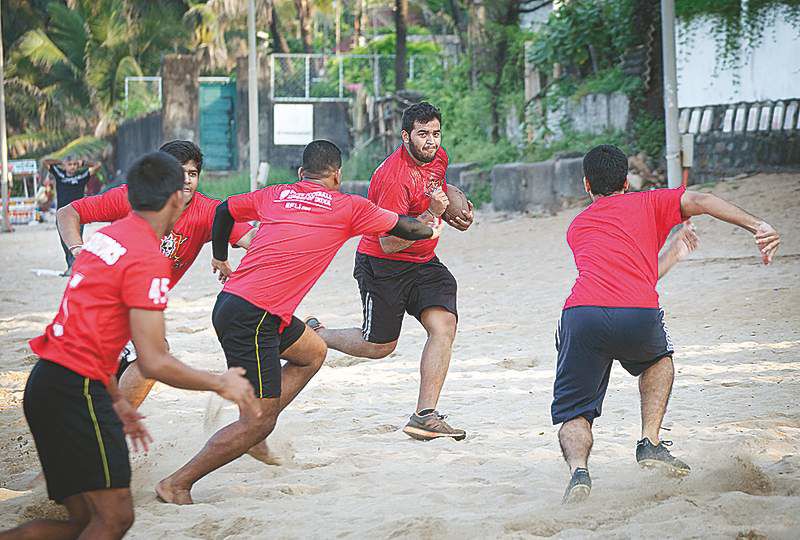Pro football making a play for India
Published 4:00 am Thursday, December 6, 2012

- Members of the Mumbai Gladiators, a professional football team, practice during an offseason workout on Juhu Beach in Mumbai, India, in October because the team does not have its own field. The Elite Football League of India has a low level of play but a large potential audience.
MUMBAI, India — On a recent Saturday morning, nearly 20 players from the Mumbai Gladiators football team went through their weekly drills and scrimmage at the popular Juhu Beach, in the suburbs north of this sprawling city of 14 million.
Dressed in red T-shirts and black shorts, the players engaged in a 90-minute practice that resembled a touch football game among friends rather than a gathering of professionals chasing dreams of fame and fortune. Elderly people and families out for walks appeared confused as they passed by. One couple approached the men to ask what game they were playing.
So it goes for the hundreds of athletes trying to catch on with the Elite Football League of India, a new and curious venture aimed at introducing American football to India, Pakistan, Sri Lanka and other countries in Asia. It is a perhaps quixotic undertaking, but it could prove to be lucrative should the game become popular within the vast population of potential fans.
“When you first watch the games, it’s laughable,” said Richard Whelan, one of the founders and co-chief executive of the league. “But if you watch it for more than five minutes, you want to know how it ends. It’s an absolute joke compared to the NFL. But it’s not a joke compared to anything else on Indian sports television, and that’s all we’re going up against.”
India has no indigenous version of football, but many of the players on the beach were successful athletes in other sports, including judo, basketball and kabaddi, a team sport in which players hold their breath and grapple with one another. Several Gladiators said they had been only dimly aware of football, though they knew of films like “The Longest Yard” and “Any Given Sunday.” None of them had played even so much as a down of the game before starting training camp a year ago in Mumbai and Pune, about 100 miles to the southeast.
“We didn’t even know it was called American football,” said Linesh Mane, a 24-year-old defensive back and former basketball player. “We thought it was rugby.”
He added, “It’s much more difficult than rugby.”
The players on the beach were actually on an offseason break, after the league’s inaugural season, which was played over about six weeks in the summer and broadcast this fall. The team was working out at the decidedly non-gridiron-like setting because it does not have its own field. Shailesh Devrukhkar, the head coach and a former rugby player and former police commando deployed in sensitive situations like hostage negotiations, expected the team to rent one when it began preparing in earnest for next season, which is expected to begin in the spring.
Investors include Warner
Under Whelan’s frenzied leadership, the league has raised $8.5 million from investors, including Kurt Warner, the retired NFL quarterback, and Brandon Chillar, a former St. Louis Ram and Green Bay Packer of Indian descent, and he is confident others investors will come on board. To keep costs to a minimum, the league stopped paying its players in the offseason and, in the first season, dispensed with stadiums, tickets, tailgating and other trappings of the American football experience. Instead, the league’s eight teams played an entire season’s worth of games at a stadium in Colombo, Sri Lanka, which was chosen partly so the Pakistani team could play Indian teams without traveling to India. Hourlong tapes of each game were shown on television over a three-month period.
The Elite Football League of India will ditch that strategy in its second season, when games in several Indian cities will be televised live. Despite the low level of play, the league’s founders claim that millions of people are interested in American sports and will watch if Indians and Pakistanis are competing, even though most Indians do not even know the league exists and cricket remains far and away the most popular sport in the country.
Whelan and his partners are not the first to try to promote Western sports in India, where most schools and colleges give short shrift to athletics. The NBA opened an office in Mumbai last year and has sent stars like Dwight Howard and Pau Gasol to the country to promote the game. It recently signed a new broadcast deal to have its games shown in the country. The NFL is still trying to secure a television deal, but it sells a subscription-based online package for fans who want to watch games.
Still, interest in and spending on sports ranging from soccer to Formula One racing appear to be growing. At the London Olympics, India won six medals, the most ever, and its returning medalists were greeted like conquering heroes and have become national celebrities. Generating excitement about a sport that people see on television, but do not play in their towns is another matter. The league requires its players to visit schools each week to promote the game, but turning those efforts into a profit may take years. “The biggest challenge we faced was educating people about the rules, as it can be very complex game,” said Oliver Luck, the former commissioner of NFL Europe, which folded in 2007. “Men don’t grow up playing the game, so there’s no reservoir of knowledge to tap into.”
Ultimately, Luck said, fans want to see high-quality competition, no matter what the game, and in India that means cricket. The EFLI did not help itself with its low-key start. There were few major events to mark the first season, and Indian newspapers and television stations have given it sparse coverage.
Growing fan interest
Venkat Ananth, a sports columnist in India for Yahoo, said he only learned of the league while switching channels on his TV. Ananth said he found the game interesting, but added that the league would not gain much of an audience unless it started playing games in Mumbai and other large cities and perhaps bringing NFL players and teams here for exhibition games.
“You can’t impose a sport on the Indian audience,” he said. “You have to build it up. Bring your stars here, play one of those games like they do in England. Otherwise, there is no point.”
One potential audience could be the tens of thousands of young people who have spent time in the United States. Amit Paranjape, a 41-year-old software entrepreneur who studied at the University of Wisconsin and lived in Dallas for 12 years, is a fan of the Packers and the Cowboys. He was excited when he learned about the league but was disappointed that none of the games would be played in Pune, where he lives and which has an EFLI team, the Marathas.
Later, he found the league’s games on television, but he said he changed the channel after a few plays because the level of competition was less compelling than an American high school football game.
“It was like a bad dream,” he said.
Indeed, in EFLI games, quarterbacks frequently throw wobbly passes that are often dropped or intercepted. In a game between the Gladiators and the Colombo Lions, a Lions running back who apparently thought he had reached the end zone spiked the ball on the 4-yard line. One of his teammates recovered the ball and scored, but the Lions missed the extra point. A Gladiators receiver then fumbled the ball on the ensuing kickoff.
Whelan and others at the EFLI are betting that the weak play will be overshadowed by the stories off the field. To that end, they have hired Ed Goren and Sandy Grossman, who produced NFL games for decades.
Grossman said the league planned to add more pageantry to its broadcasts and was talking with executives in Bollywood, which is famous for producing movies featuring lavish dance scenes. For now, he is focused on teaching his staff where to point the cameras.
“I had to talk to a lot of different crews who had never seen football before,” he said. But “the guys playing, what they lack in quality of play, they make up in enthusiasm.”
‘Jerry Rice of India’
Many players found the sport by chance. Rahul Kelaskar, a 24-year-old wide receiver for the Gladiators, was recruited when Whelan spotted him working at a hotel in Mumbai. Kelaskar is 6-foot-5 but weighs 125 pounds, earning him the nickname Sticks from his coaches.
Despite knowing little about the sport and over the opposition of his parents, with whom he lives, Kelaskar quit his 30,000-rupee a-month ($555) job at the hotel to join the Gladiators, who pay their players about 15,000 rupees ($277) a month.
Despite the league’s shaky prospects, Kelaskar dreams of becoming “the Jerry Rice of India” and is convinced that he made the right choice.
Still, Mane and several teammates said they were concerned that the league had not played exhibition games and taken other steps to market the game.
“You need to have a promotions strategy,” said Preetesh Balyaya, a 26-year-old offensive lineman on the Gladiators. He said he still believed in the league’s founders and did not mind not being paid in the offseason. Unlike many other players, Balyaya has a family business to return to if football does not pan out.
“Money is not a big thing,” he said. “You can’t run behind money. You have to run behind passion.”








